The Imaging Resource
Quick Review
Panasonic Lumix DMC-FX9 Digital Camera
| Camera QuickLook | ||
|
By
|
Mike Pasini
|
|
|
Review Date |
|
|
|
User Level |
|
|
|
Product Uses |
|
|
|
Digicam Design |
|
|
|
Picture Quality |
Excellent, 6.0-megapixel CCD | |
|
Print Sizes |
Good 11x17 inches, or 8x10 with heavy cropping | |
|
Availability |
|
|
| Suggested Retail
Price (At introduction) |
|
|
Introduction
|
|||||||
Panasonic has been an interesting player in the digital camera market for the last few years. The 6.0-megapixel Panasonic Lumix DMC-FX9 adds a little more interest by steadying its 3x zoom with Panasonic's MEGA optical image stabilizer. Panasonic is somewhat unique in this area, offering stabilization on camera models that offer as little as 3x optical zoom, where other manufacturers until recently have restricted the feature to their long-zoom cameras. While stabilization on a 3x zoom camera like the Panasonic Lumix FX9 may not be as much of a necessity as it would be on a long-zoom digicam, it does make a useful difference in the photos you'll be able to shoot in available light -- without flash and, therefore, without red-eye. You'll also need a tripod much less often, and those times when a tripod just isn't an option, you won't have to resort to boosting the ISO sensitivity (and noise levels) as much as you might have with a non-stabilized camera. If you're in the market for an affordable digital camera with the advantages of optical image stabilization, the Lumix FX9 could be the camera for you.
With the rather minimalist styling that seems to be a hallmark of the company's Lumix series, the Panasonic Lumix DMC-FX9 offers a stabilized Lumix DC Vario Elmarit 3x optical zoom lens. Measuring 3.7 x 2.0 x 0.95 inches (94.1 x 50.5 x 24.2 millimeters), the DMC-FX9 weighs approximately 5.36 ounces (152 grams) with the battery and storage card installed. The Lumix FX9's all-plastic, matte-silver body helps keep the camera's weight down. Small enough to slip into your shirt pocket, the FX9 should be able to go wherever you do. An accompanying wrist strap adds a sense of security when shooting with the camera.
Fairly quick on the draw thanks to a smooth retractable lens design, the Panasonic Lumix FX9 is a convenient point-and-shoot digital camera with a handful of extra exposure features for further flexibility, plus the added bonus of an optically stabilized lens -- unusual in a camera with this form factor and price. With the lens retracted, the DMC-FX9's front panel is nearly flat except for a small bulge around the lens opening and a smaller protrusion that serves as the hand grip. Other than these, the body panels are mostly smooth and flat. When extended, the lens projects a further three-quarter inch from the camera's front. Equipped with a 6.0-megapixel CCD, the Lumix FX9 captures high quality images, suitable for making sharp prints as large as 11x17 inches, or 8x10 inches with heavy cropping. Smaller image sizes are also available for email transmission or Web applications, and a movie mode captures video clips with sound. Still images offer two JPEG compression levels: Fine and Standard.
The Lumix FX9 features a 3x, 5.8-17.4mm zoom lens, equivalent to a 35-105mm zoom on a 35mm camera. Aperture is automatically controlled, with either f/2.8 or f/5.6 possible at full wide angle, and either f/5.0 or f/10.0 at full telephoto. A maximum 4x digital zoom option increases the DMC-FX9's zoom capability to 12x, but keep in mind that digital zoom decreases the overall image quality, because it simply crops out and enlarges the center pixels of the CCD's image. Image details are thus likely to be softer when using digital zoom. Focus ranges from 1.6 feet (50 centimeters) to infinity in normal AF mode, and from 2.0 inches to infinity (5 centimeters to infinity) in Macro mode. The FX9 employs a five-point autofocus system to determine focus, which uses a broad active area in the center of the image to calculate the focal distance. Through the menu, you can set the focusing system to use only three or one of these five focusing points, or set the Lumix FX9 to a spot AF mode that measures focus from a smaller point at the very center of the image. The Lumix FX9 also has an AF assist lamp to aid focus in low light.
For composing images, the Lumix FX9 forgoes an optical viewfinder in favor of a large 2.5-inch color LCD monitor with 114,000 pixels resolution. The LCD reports a fair amount of camera information, including exposure information such as aperture and shutter speed when you half-press the shutter button, as well as a record-mode histogram display which reports the tonal distribution of a captured image several times a second, useful in determining any over- or under-exposure. The same information (including the histogram) is available in Playback mode as well.
Exposure control on the Lumix FX9 is automatic, as might be expected for a point and shoot camera. Instead of fully manual controls, a series of Scene modes aim to give users some control over their images. Main camera modes are controlled by a mode dial on the camera's top panel. Choices include Normal (similar to Auto on most cameras), Simple (which hides most menu functions from beginners), Macro, Scene (with choices being Portrait, Sports, Food, Scenery, Night Portrait, Night Scenery, Baby, Soft Skin, Candle Light, Party, Fireworks, Snow, Starry Sky, and Self-Portrait), Movie, and Playback. Shutter speeds range from 1/2,000 to 8 seconds, with the one- to 8-second end of the range only available in the Night Scene modes, although you can select among 1/8, 1/4, 1/2 and one second when the Slow Shutter feature is enabled. In Normal mode, the camera controls everything about the exposure except for image size/quality, flash, ISO sensitivity, white balance, AF mode, self-timer, and burst-mode. Camera operation is straightforward, as you typically just point and shoot most of the time. Pressing the Shutter button halfway sets focus and exposure, and the LCD display (plus an audible beep) let you know when the camera is ready to take a picture.
The Lumix FX9's Scene modes tweak exposure variables to accommodate common photographic situations. Portrait mode enhances flesh tones outdoors in daylight, using a large aperture setting to reduce depth of field for blurred backgrounds and strong focal emphasis on the primary subject. Sports mode instead sets fast shutter speeds and wider apertures adjusting ISO automatically, in effect "freezing" fast-paced action. Food mode uses the Macro focus range and neutralizes the ambient light, giving the subject a more natural hue. Scenery mode is for capturing wide landscapes, and sets autofocus priority to infinity. Night Portrait mode uses a slow shutter speed, up to one second, but relies on the flash to illuminate the primary subject in the foreground. Night Scenery mode extends the slowest shutter speed to eight seconds to capture the color and detail of evening settings without using the flash. Because of the slow exposure, a tripod is recommended. The flash is disabled and ISO set at 80. Baby mode enhances flesh tones and tones down the flash when used. During playback, the baby's age can be displayed when the birthday is set in advance in the Lumix FX9's Baby scene dialog box. Soft Skin mode smooths any skin tone it detects in the image. Candle Light captures the atmosphere of candle-lit subjects, with a tripod recommended. Party mode is best for taking pictures under dim indoor lighting with a flash. You can select between Forced Red-Eye Reduction and Slow-Sync Red-Eye Reduction modes, and a tripod is recommended. Fireworks mode preserves the color and pattern of fireworks by using a slow shutter speed to capture the full effect (a tripod is recommended). Snow mode captures good exposures in bright, snowy conditions, and adjusts the white balance and exposure to ensure the bright snow doesn't trick the camera into underexposure or color casts. Starry Sky handles scenes that are extremely dark but requires a tripod. Finally, Self Portrait mode the lens is set at wide angle, image stabilization is enabled and autofocus uses 5-area focusing. You can record audio with your self portrait, too.
The Panasonic Lumix FX9 uses an Intelligent Multiple metering system, which means that the camera divides the image area into zones and evaluates both contrast and brightness among all the zones to determine the best overall exposure. Exposure Compensation increases or decreases the overall exposure from -2 to +2 exposure equivalents (EV) in one-third step increments. A White Balance option offers Auto, Daylight, Cloudy, Halogen, and White Set (manual) settings. A White Balance Adjust function lets you bias the white balance from either a preset or the White Set option, with 21 arbitrary steps (10 either side of the default, toward red or blue). The Lumix FX9 also offers a Color Effect setting with Cool, Warm, Black and White, and Sepia color options. A Picture Adjustment menu option features an additional adjustment tool, with options somewhat deceptively labeled as "Natural," and "Vivid," in addition to the default "Standard." What's wrong with that? These options actually affect the amount of in-camera sharpening applied to the images, rather than color saturation, as you'd expect. Sensitivity equivalents include 80, 100, 200, and 400 ISO settings, as well as an Auto setting. The Lumix FX9's built-in flash operates in Auto, Auto with Red-Eye Reduction, Forced On, Forced On with Red-Eye Reduction, Slow-Synch with Red-Eye Reduction, and Forced Off modes.
Three burst modes capture a series of consecutive images for as long as the Lumix FX9's shutter button is held down (much like a motor drive on a traditional camera), with the high-speed burst mode capturing three images in a one second period at the highest resolution/quality. The low-speed mode captures three maximum quality images at two frames per second. An unlimited burst mode captures images for as long as there is available battery life and memory available, at approximately 1.5 frames per second. For the former two modes, exposure and white balance are locked at the values set for the first photo; in the unlimited mode, the exposure and white balance can vary from shot to shot. The Lumix FX9's flash cannot be used in the burst modes. The actual frame rate of all three burst modes vary slightly with the resolution setting, and the maximum number of images will also depend on the amount of memory card space and file size. Panasonic also notes that MultiMediaCards are slower than SD cards. In high-speed continuous mode though, the Lumix FX9 can capture up to three large/fine JPEG images at a rate of just under three frames/second. This is a pretty good clip, but the three-frame limit is a bit low by current standards. A two- or 10-second self-timer option counts down by flashing a small red LED on the front of the camera before firing the shutter, giving you time to duck around the camera and get into your own shots. Finally, the self-timer can be used in cooperation with the burst modes, in which case three images are captured automatically at the burst mode speed once the initial timer has completed.
The Panasonic Lumix DMC-FX9 also has a Movie Record mode, which records moving images with sound for as long as there is available battery life and flash card space, depending on the resolution setting. Movies are recorded at either 640 x 480 or 320 x 240 pixels, with a frame rate of either 30 or 10 fps. Like many cameras, the optical zoom, aperture and focus are fixed from the first frame of the movie onwards. Some cameras allow the digital zoom to be changed during movie recording, but the Lumix FX9 does not. The optical stabilizer can be used during movie recording (in mode one only), as can the Color Effects function. The camera's Playback mode allows movies to be paused, and cued in forward or reverse direction using the cursor buttons, but does not allow you to step through the movie frame by frame, or edit it in-camera.
The Panasonic Lumix FX9 uses SD/MMC memory cards for image storage. A 16-MB SD memory card is supplied with the camera. I highly recommend picking up a high capacity card, so you don't miss any shots. These days, 128- to 256-MB is a good tradeoff between cost and capacity.
Entire SD cards can be write-protected by using the physical switch on the side of the card, but if you don't want to remove the card to do so, the Lumix FX9's Play menu also allows you to write-protect individual image files, protecting them from accidental erasure, unless the card is formatted.
The camera uses a proprietary Panasonic CGA-S005E lithium-ion battery pack rated at 3.7 volts and 1150 mAh. The optional AC adapter kit may also prove a useful purchase for preserving battery power when reviewing and downloading images, or if you do a lot of shooting with the camera on a tripod. A USB cable and interface software are also packaged with the camera, for downloading images to a computer and performing minor organization and corrections. An A/V cable connects the FX9 to a television set, for reviewing and composing images. The Lumix FX9 is Digital Print Order Format (DPOF) and PictBridge compatible, with detailed print settings in the Playback menu. A software CD accompanies the camera, containing PhotoImpression, Panorama Maker, and PhotoBase by Arcsoft for both Mac and Windows platforms, which provide photo manipulation, stitching, and organization functions respectively.
Basic Features
- 6.0-megapixel CCD
- 2.5-inch color TFT LCD monitor
- 3x, 5.8-17.4mm lens, equivalent to a 35-105mm lens on a 35mm camera
- Maximum 4x digital zoom
- Automatic exposure control, with Long Shutter mode for longer exposures
- Shutter speeds from 1/2,000 to 8 seconds
- Maximum aperture of f/2.8 to f/5.0, depending on lens zoom position
- Built-in flash with five modes
- SD memory card slot for storage
- Power supplied by proprietary lithium-ion battery, or optional AC adapter kit
- Software CD included for both Windows and Mac platforms
Special Features
- Optical image stabilization with two modes
- Movie mode with sound
- Continuous Shooting modes
- Two- or 10-second Self-Timer for delayed shutter release
- Audio Dub option for recording captions
- Intelligent Multiple exposure metering
- White balance (color) adjustment with five modes, including a Custom setting
- White Balance Adjust function allows fine-tuning of preset or custom white balance
- Color Effects including Cool, Warm, Black and White, and Sepia
- Adjustable image sharpening
- Adjustable ISO setting
- DPOF (Digital Print Order Format) and PictBridge compatibility
- USB cable for connection to a computer (driver software included)
- A/V cable for connection to a television set
Recommendation
Panasonic's Lumix series of digital cameras have proven to be very popular option with consumers, thanks to a combination of competitive prices, good resolution and feature-set, and the fact that almost every current model offers optical image stabilization (a feature other manufacturers seem to reserve only for their long-zoom digicams). Although exposure control is mainly automatic, the availability of exposure times as long as 8 seconds and adjustable ISO increases the Lumix FX9's exposure versatility a great deal. The uncomplicated user interface helps novices and more advanced amateurs alike feel at home, and a generous selection of scene modes gives some sense of control over the final image. The really big news with the FX9 though, is its 3x optically-stabilized zoom lens, and its price point. The Panasonic Lumix DMC-FX9 makes a good "all around" camera and would be a credible second camera for enthusiasts for those times when they don't want to lug along their full-size all-the-bells-and-whistles digital SLR.
With the minimalist styling that's been a hallmark of the company's Lumix lineup, the Panasonic Lumix FX9 looks clean and functional, with a 3x Lumix DC Vario-Elmarit optical zoom lens that dominates the front panel. Measuring 3.7 x 2.0 x 0.95 inches (94.1 x 50.5 x 24.2 millimeters), the DMC-FX9 weighs approximately 5.36 ounces (152 grams) with the battery and storage card installed. The Lumix FX9's all-plastic, matte-silver body helps keep the camera's weight down. It slips easily into your shirt pocket, and an accompanying wrist strap offers a sense of security when carrying the camera. I'd also recommend picking up at least a small camera bag to protect the camera body from scratches.
The front of the Panasonic FX9 naturally features the telescoping 3x Lumix DC Vario zoom lens. Above and to its right is the combination self-timer indicator and autofocus assist lamp. On the other side of the lens is the flash and below that on the left side of the front panel is a small sculpted grip.
The right side of the Lumix FX9 (as viewed from the back) features only the Audio / Video port which doubles as the Digital Out port, and the DC In connector, both behind the same small plastic door. Above that is an eyelet for the wrist strap.
The opposite side of the camera is featureless.
The Lumix DMC-FX9's top panel features a small speaker next to a microphone, which are left of the On/Off switch. To the right of the power switch is the Zoom lever surrounding the Shutter button. In the far right corner is the Optical Image Stabilizer button. On the very back edge of the right side of the panel is the Mode dial, which is inset under the top panel, revealing only its icons along the outer edge.
The majority of the exposure controls are located on the camera's rear panel, along with the 2.5-inch LCD monitor, which consumes most of the space. To the right of the Lumix FX9's monitor are the four cursor buttons that act like a Five-Way Arrow Pad. The Menu button is centered between them. Below them and to the left is the Display / Power LCD button to cycle through the Display options or momentarily brighten the LCD (when held down for a second) in bright daylight. To the right of that is the Burst mode / Delete button. A textured thumb grip at the very top right corner of the camera's rear reinforces the modest handgrip on the Lumix FX9's right side.
The Panasonic Lumix FX9's bottom panel is reasonably flat, with a spring-loaded door to access the SD/MMC memory card slot and battery compartment at the right of the camera, and a threaded plastic tripod mount near the left rear corner. The battery and card do not fall free when the door is opened, with the battery being held in place by a sliding lock. The tripod mount is positioned off-center from the lens, and is too close to the corner of the camera to provide a stable platform. The tripod mount should be far enough from the battery compartment to allow for quick battery changes (something I'm probably more sensitive to than most users, given the amount of on-tripod shooting I do).
The Panasonic Lumix DMC-FX9's user interface is straightforward and should present a relatively short learning curve if you read through the included manual. (There are a lot of features here, though, so I'd imagine that novice users could easily spend a couple of hours learning them all. Experienced digicam users should be able to come up to speed on the major functions in under an hour though.) I generally prefer to see external access to as many exposure controls as possible, and the DMC-FX9 does provide a fair amount of control without resorting to the LCD menu system. When needed, the menu system itself is straightforward and reserved for the less frequently used options.
Record Mode Display: In any record mode, the Lumix FX9's LCD display shows either the image area with information, image with information and live histogram, alignment grid, and image with no information modes. Pressing the Display button cycles through the available displays. When the information display is active, it reports battery life, resolution and image quality settings, the number of available images, Record mode, orientation, and a handful of exposure settings (including the predicted aperture and shutter speed).
Playback Mode Display: The Lumix FX9's Playback mode also offers three display modes, including the image only, the image with information, and the image with expanded information and a histogram. You can also display nine, sixteen, or twenty five thumbnail images at a time on-screen with the index display mode, or zoom in by up to 16x on captured images to check fine details, focus, or framing.
External Controls
Shutter Button: Located on the right side of the Lumix FX9's top panel and surrounded by the Zoom lever, the Shutter button sets focus and exposure when halfway pressed, and when fully depressed, it trips the shutter release. In Self-Timer mode, fully depressing the Shutter button triggers a two- or 10-second countdown before the shutter is released.
Zoom Lever (see image above): Surrounding the Lumix FX9's Shutter button, this lever controls the optical and digital zoom in any Record mode.
In Review mode, pushing the Lumix FX9's zoom lever toward the "W" end activates a nine-, sixteen-, or twenty-five-image index display mode. Pushing the lever to the "T" end digitally enlarges a captured image as much as 16x. When playback zoom is active, pushing the lever back toward the "W" zooms back out.
Mode Dial: To the left of and slightly behind the Lumix FX9's Shutter button, this notched dial on the camera's top panel is used to select the camera's shooting modes as follows:
- Normal Mode: Sets the camera for image capture, with all variables except for image size / quality, optical / digital zoom, flash mode, ISO sensitivity, white balance, AF mode, self-timer, and burst mode set automatically.
- Simple Mode: This would be the "green" or "Auto" mode on other cameras, Panasonic calls it the "Simple" mode. In this mode, most user options are removed, allowing control only over image resolution (with options of "Enlarge," "4x6," or "E-Mail), Beep (off/low/high), and Clock Set. Continuous-mode options are reduced to a single choice, and instead of exposure compensation adjustments, the up arrow on the four-way controller simply toggles a Backlight option. Flash options are reduced to just Off, On, and Auto with Red-Eye Reduction. The self-timer function offers only a 10-second option, and the image stabilizer is permanently set to Mode 1.
- Macro Mode: Sets the camera for image capture, and allows you to take close-up pictures of your subject. Whereas regularly the camera will only focus as close as 50cm (regardless of zoom setting), in Macro mode the camera can focus as close as 5cm at the wide position (the camera can actually still focus to infinity in Macro mode, although it may take longer to hunt for focus since the overall zoom range is wider).
- Scene Modes: Scene mode choices are Portrait, Sports, Food, Scenery, Night Portrait, Night Scenery, Baby, Soft Skin, Candle Light, Party, Fireworks, Snow, Starry Sky, and Self-Portrait.
- Movie Mode: Records short movie clips with sound, at 640 x 480 or 320 x 240 pixels, both at 30 or 10 fps. The actual amount of recording time is limited only by the capacity of the SD card in the camera (and of course the remaining battery life). A handful of exposure controls are available in this mode, including exposure compensation, white balance, frame rate, AF mode, digital zoom, optical stabilization, and color effect. However, once recording starts, the aperture, optical and digital zoom, and focus are locked for the duration of recording.
- Playback Mode: This mode allows you to scroll through captured images and movies, write-protect images, view a nine-image index display, zoom into a captured image, delete unwanted images, rotate images, set up images for printing on DPOF compatible devices, as well as play movies.
Optical Image Stabilizer Button: Directly to the right of the Lumix FX9's Shutter button / Zoom lever combo on the top panel, this button accesses the camera's image Stabilizer function, which attempts to reduce image blurring caused by camera shake. The Lumix FX9's Stabilizer can be disabled altogether, or can be set to Modes 1 or 2. In Mode 1 the Stabilizer functions continuously. Mode 2 operates the Stabilizer only during the actual image capture, which conserves power and potentially provides a slightly better chance of capturing a blur-free image (when in Mode 1, the Stabilizer may already have used much of its available range to correct shake that occurred just before the shutter was released, and hence may not have as much latitude to correct the shake during the actual exposure).
Power Switch: To the left of the Shutter button, this sliding switch turns the camera on or off. Powering the camera on with the Mode dial set to a record mode triggers the lens to extend. (Likewise, turning the camera off causes the lens to retract.)
Display Button: On the rear of the Lumix FX9, directly to the right of the LCD display, this button controls the image and information displays in Record and Playback modes. In Record mode, pressing the button cycles between the four display modes, which include the image with information, image with information and live histogram, alignment grid, and image with no information modes.
In Playback mode, pressing the button cycles between the image with information, expanded information and histogram, and no information displays.
Cursor Buttons: Located directly above the Lumix FX9's Display button, this group of four cursor buttons circling the Menu button accesses a variety of camera settings. Menu options are navigated and camera settings adjusted using the buttons as arrow keys. In addition, in most Record modes the Up arrow accesses the Exposure Compensation, Auto Exposure Bracketing, and White Balance Adjustment tools. The Right arrow cycles through the available Flash modes, while the Left arrow cycles through the Self-Timer modes. The Down arrow activates a quick review of the most recently captured image. In Simple mode, the Up arrow instead activates a backlight compensation feature.
In Playback mode, the right and left arrow keys navigate through captured images and movie files. The down arrow key starts or stops movie playback. While a movie is playing, the left and right arrow keys cue through the movie, while the up arrow key pauses the movie. When an image has been digitally enlarged, the four arrow keys pan around within the image.
Menu Button (see image above): In the middle of the Cursor buttons is the Menu button, which calls up the settings menus on the LCD display in all camera modes. A further press of the Menu button cancels the menu display.
Burst Mode / Delete Button: Directly to the right of the Lumix FX9's Menu button. In most record modes, this button accesses the three Burst modes (High, Low, or Infinity), or returns to the single-shot mode. In Playback and Review modes this button pulls up the delete menu.
Camera Modes and Menus
Record Mode: In Record mode, the camera can capture still images or movies, with a range of options available through the Settings menu. The Exposure Mode dial sets the exposure control mode. The Lumix FX9's LCD menu -- accessed by pressing the Menu button in any record mode -- provides the following exposure options (some options are not available in all modes):
- Record Menu: Available in all Record modes on the Lumix FX9, but depending on camera setup, it may take a second press of the Menu button to access the menu from the Scene modes. The Record menu offers the following selections:
White Balance: Sets the white balance to Auto, Daylight, Cloudy, Halogen, Manual, or White Set modes. (White Set isn't a separate white balance mode, it's just the option for manually setting the white point that's selected by the Manual option.)
- Sensitivity: Adjusts the camera's sensitivity setting. Choices are Auto, 80, 100, 200, or 400 ISO equivalents.
- Aspect Ratio: Sets the aspect ratio to 4:3, 3:2 or 16:9
- Picture Size: Sets image resolution to 6 megapixel, 3 megapixel, 2 megapixel, 1 megapixel or 0.3 megapixel (640 x 480.
- Quality: Sets the image compression to Fine or Standard.
Audio Recording: When enabled, causes the camera to record five seconds of audio with each still photo. (Audio recording isn't available when shooting in one of the camera's continuous modes.)
- AF Mode: Sets the AF area mode to Five-Area, Three-Area, One-Area, or Spot.
- AF Assist Lamp: Turns the autofocus assist lamp on or off.
- Slow Shutter: Selects the slowest shutter speed the camera can use, giving you some measure of control over exposure in poor lighting conditions. Choices are 1/8th, 1/4, 1/2, or 1 second, although this is only a baseline - the camera may still choose a faster shutter speed if its exposure metering determines that there is enough light to do so.
- Digital Zoom: Enables or disables the digital zoom option.
Color Effect: Selects a color effect, with options of Cool, Warm, Black and White, or Sepia.
- Picture Adjust: Offers three settings - Natural, Standard or Vivid. The natural setting gives a softer image, while the Vivid setting offers increased sharpness, as compared to the default Standard setting.
- Scene Menu: For each Scene mode option, you can press the left arrow button on the Lumix FX9 to receive a brief description of the mode.
Portrait: Utilizes a larger aperture to decrease the depth of field, and emphasizes flesh tones, resulting in a sharply focused subject in front of a slightly blurred background.
- Sports: Employs a faster shutter speed to "freeze" fast-moving action.
- Food: Takes a macro shot of food with a more natural hue than the ambient lighting may provide.
Scenery: This mode fixes focus at infinity, and is best for capturing wide vistas and landscapes.
- Night Portrait: As with the mode above, the camera uses a slower shutter speed for better color in night shots. However, the flash is set to Slow-Sync with Red-Eye Reduction mode.
- Night Scenery: In this mode, the camera slows the shutter speed to as long as 8 seconds, capturing more ambient light and preserving color in darker exposures. (The flash is disabled.)
Baby: Enhances flesh tones and tones down the flash when used. During playback, the baby's age can be displayed when the birthday is set in advance in the Baby scene dialog box.
- Soft Skin: Smooths any skin tone it detects in the image.
- Candle Light: For capturing the atmosphere of candle-lit subjects. Tripod recommended.
Party: Best for taking pictures under dim indoor lighting with a flash, you can select between Forced Red-Eye Reduction and Slow-Sync Red-Eye Reduction modes. Biases white balance for indoor lighting.
- Fireworks: Here, the camera uses a slower shutter speed and enhances color slightly to capture the full pattern and color of fireworks.
- Snow: This mode adjusts the white balance and exposure to counter the bright snowy areas of the scene, preventing the camera being fooled into underexposing the shot.
Starry Sky: For taking pictures of extremely dark subjects like a starry sky. Requires a tripod.
- Self Portrait: Sets the lens at wide angle, image stabilization is enabled and autofocus uses 5-area focusing to make sure it catches the closest objects (rather than focusing between two heads). You can record audio with your self portrait.
- Play Menu: This menu is only available in the Lumix FX9's Review mode when set by the dial (not by use of the REV button). It lets you erase, protect, and rotate captured images or movies; or set up images for printing on a DPOF compatible device. The Play menu offers the following selections:
Slide Show: Automatically plays all images or only DPOF selected files in a slide show format. You can designate the display interval for images from one to five seconds, and audio can be enabled or disabled.
- Favorite: Enables or disables Favorite display.
- Rotate Display: Selects whether images that were tagged as rotated by the camera's orientation sensor, or using the next menu option, should be shown rotated on the LCD display.
- Rotate: Rotates captured images in steps of 90 degrees using the Exif tag only. The actual image data is not touched, which may confuse other programs that do not look at the Exif orientation tag.
- DPOF Print: Marks individual or multiple images for printing on a DPOF compatible printer, or cancels marking of images.
Protect: Write protects the currently displayed image, protecting it from accidental deletion, except by card formatting. There's also an option for protecting multiple images at once, or to cancels protection of images.
- Audio Dub.: Lets record a brief audio clip (max. 10 seconds) to attach to the currently reviewed image.
- Resize: Lets you resize an image to a smaller resolution and save a separate copy.
- Trimming: Sort of like a cropping function, this option lets you "trim" an image and save it as a separate file. To trim the image, you use the Playback zoom and pan functions to select the area of the image that you want to retain on the display, and then press the shutter button to save the cropped image.
- Clean Up: Optimizes the write speed of the SD card, apparently defragmenting it.
Format: Formats the SD/MMC card, erasing all files (including those that were protected using the Protect menu option).
- Setup Menu: The Setup menu provides universal camera control options that remain the same in both Shooting and Review modes. This menu is accessed by depressing the Lumix FX9's Menu button once and scrolling to the right with the Multicontroller. Following are the available settings:
Monitor: Adjusts the brightness level of the LCD monitor in seven steps.
- Auto Review: Disables the automatic image review, or sets the review time to one or three seconds. A Zoom option displays the captured image for one second, then zooms it 4x for one second. The Zoom option does not zoom images shot in burst mode, with auto-bracketing, or with audio clips recorded.
- Power Save: Lets you enable or disable the camera's auto power off feature, and change the time before the LCD display "sleeps" to 1, 2, 5, or 10 minutes.
- Economy: Enables various battery-saving measures like turning off the LCD while the flash is charging or when the camera is inactive after 15 seconds.
- Beep: Turns the camera's beep sound on or off, with low and high volume settings.
Volume: Sets the speaker volume.
- Clock Set: Sets the camera's internal clock and calendar.
- No. Reset: Resets file numbering with each new SD/MMC card (Yes setting), or continues file numbering from card to card (No setting). (Continuous file numbering is very handy to avoid accidentally overwriting images you've previously copied to your computer's hard drive.)
- Reset: Resets all record-menu settings to their factory defaults.
- USB Mode: Sets the USB mode to PC or PictBridge (PTP).
Video Out: Sets the video output timing to NTSC or PAL. (NTSC for the US and Japan, PAL for most of Europe.)
- Scene Menu: Sets whether to automatically display a Scene mode menu when Scene mode is selected on the Mode dial or use the last selected mode, accessing the options by pressing the Menu button.
- Language: Selects the menu language from English, German, French, Spanish, Italian, Chinese Traditional and Japanese.
In the Box
Packaged in the box are the following items:
- Lumix DMC-FX9
- 16-MB SD memory card
- Lithium-ion battery pack
- Battery charger
- USB cable
- Audio / Video cable
- Software CD-ROM
- Wrist strap
- Battery carrying case
- Large capacity SD/MMC memory card. (These days, 128-MB to 256-MB is a good tradeoff between cost and capacity.)
- High-capacity rechargeable NiMH batteries and charger.
- AC adapter kit
- Small camera case
Recommended Software: Rescue your Photos!
Just as important as an extra memory card is a tool to rescue your images when
one of your cards fails at some point in the future. We get a lot of email from
readers who've lost photos due to a corrupted memory card. Memory card corruption
can happen with any card type and any camera manufacturer, nobody's immune.
A lot of "lost" images can be recovered with an inexpensive, easy
to use piece of software though. Given the amount of email I've gotten on the
topic, I now include this paragraph in all my digital camera reviews. The program
you need is called PhotoRescue, by DataRescue SA. Read our review
of it if you'd like, but download the program now, so you'll have it.
It doesn't cost a penny until you need it, and even then it's only $29, with
a money back guarantee. So download PhotoRescue
for Windows or PhotoRescue
for Mac while you're thinking of it. (While you're at it, download the
PDF manual
and quickstart
guide as well.) Stash the file in a safe place and it'll be there when you need
it. Trust me, needing this is not a matter of if, but when... PhotoRescue
is about the best and easiest tool for recovering digital photos I've seen.
(Disclosure: IR gets a small commission from sales of the product, but I'd highly
recommend the program even if we didn't.) OK, now back to our regularly
scheduled review...
Test Results
We ran the Panasonic Lumix DMC-FX9 through our usual battery of tests, and have summarized our findings here. To see the full set of our test images, with explanations of what to look for in them, see the Panasonic Lumix DMC-FX9 Sample Pictures page. For a complete listing of all our test and "gallery" shots, go to the Thumbnails page.
Not sure which camera to buy? Let your eyes be the ultimate judge! Visit
our Comparometer(tm)
to compare images from the DMC-FX9 with those from other cameras you may be
considering. The proof is in the pictures, so let your own eyes decide which
you like best!
Lens
Zoom
A typical 3x optical zoom range, with good performance.
| 35mm |
105mm |
4x Digital Zoom |
The Panasonic Lumix DMC-FX9 zooms over the equivalent of a 35-105mm range, which is a typical zoom range for its class. Details are a little soft at wide angle, with some noticeable coma distortion in the trees, but results are still quite good. The 4x digital zoom takes it out to 12x total with some loss of quality, but still pretty good detail.
Macro
A small macro area with great detail and high resolution. Flash had
trouble and overexposed the frame.
| Standard Macro | Macro with Flash |
The Lumix FX9's macro setting performed very well, capturing a small minimum area of 1.93 x 1.45 inches (49 x 37 millimeters). Detail and resolution were both very good, though with rapid softening radiating from the center, beginning right around the oval surrounding the "1" in the dollar bill. (Most cameras have some softening in the corners in macro mode.) The flash had more than a little trouble throttling down for the small area, and overexposed the shot quite a bit, with uneven coverage. (Plan on using external lighting for your closest macro shots with the DMC-FX9.)
Distortion
Low barrel and pincushion distortion.
This is the tendency for the lens to bend straight lines outward (like a barrel--usually at wide angle) or inward (like a pincushion--usually at telephoto). The Panasonic Lumix FX9's 0.4% barrel distortion at wide angle is actually quite low among the cameras I've tested, though it is noticeable in the frame. At the telephoto end, the DMC-FX9's 0.07% pincushion is also low.
| Barrel distortion at 35mm is 0.4% |
| Pincushion at 105mm is 0.07% |
Chromatic aberration
Moderately high at wide angle, though much lower at telephoto.
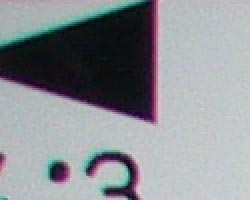 |
 |
| Wide: moderately high, top left @ 200% | Wide: fairly bright, top right @ 200% |
 |
 |
| Tele: quite low, top left @200% | Tele: quite low, top right @200% |
Chromatic aberration is a bit high at wide angle on the Lumix FX9, showing about 6-7 pixels of bright coloration on either side of the target lines, but decreases to very low levels at telephoto focal lengths. (This distortion is visible as a very slight colored fringe around the objects at the edges of the field of view on the resolution target.)
Corner Sharpness
Fairly strong softening in the upper corners of the frame, strongest
effect in the upper right corner at both zoom settings.
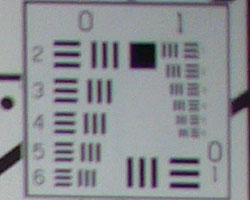 |
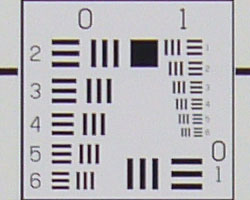 |
| Wide: quite soft in the upper right corner. | Wide: much sharper at center. |
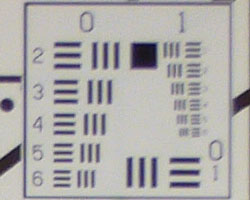 |
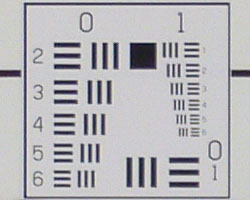 |
| Tele: quite soft in the upper right corner. | Tele: sharper at center. |
The Panasonic Lumix DMC-FX9 produced soft corners in a few shots, most notably in the upper corners of the frame. The strongest effect at both wide angle and telephoto was in the upper right corner, though all corners were a little soft.
Sensor
Exposure and White Balance
Indoors, incandescent lighting
Warm cast with both Auto and Incandescent white balance settings. Average exposure compensation required.
| Auto White Balance +1.0EV | Incandescent WB +1.0EV |
| Manual White Balance +1.0EV |
The Lumix FX9's color balance indoors under incandescent lighting was quite warm and reddish in Auto white balance mode, and the Incandescent setting differed very little. It took manual White Balance to compensate for this camera's inability to compensate for our somewhat harsh test. The Panasonic Lumix FX9 required a +1.0EV exposure compensation boost to get a good exposure, about average for this shot. Overall color is a bit dark and yellow here, making the blue flowers very dark and purplish. (A very common outcome for this shot.) Our test lighting for this shot is a mixture of 60 and 100 watt household incandescent bulb, a pretty yellow light source, but a very common one in typical home settings here in the US.
Outdoors, daylight
Good color balance, very bright colors. Better than average exposure accuracy.
| Auto White Balance, Auto Exposure | Auto White Balance, Auto Exposure |
Outdoor shots generally showed accurate exposure with slightly blown out highlights with the Lumix FX9. The shadows also lost some detail, though general exposure accuracy was still quite good.
See full set of test images with explanations
See thumbnails of all test and gallery images
Resolution
High resolution, 1,200 lines of strong detail.
Our laboratory resolution chart revealed sharp, distinct line patterns down to about 1,200 lines per picture height, with extinction at around 1,650-1,700. (The camera produced slight color artifacts at lower line frequencies, visible in the full-sized res target shots.) Use these numbers to compare with other cameras of similar resolution, or use them to see just what higher resolution can mean in terms of potential detail. Beware that while you might be able to make out what looks like distinct lines at numbers higher than those we've mentioned here, the camera is just doing its best to continue interpreting the lines. If you zoom in and follow them from the wider portions, you'll see the lines converge and reappear several times, so the lines you see at 1,600 and higher are really only artifacts generated by the camera's imaging system.
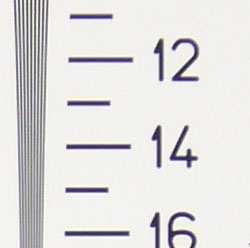 |
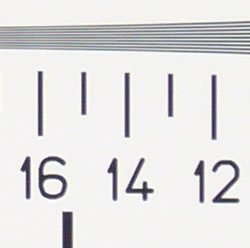 |
| Strong detail to 1,200 lines horizontal | Strong detail to 1,200 lines vertical |
See full set of test images with explanations
See thumbnails of all test and gallery images
Sharpness & Detail
Slightly soft images overall, though still pretty good definition.
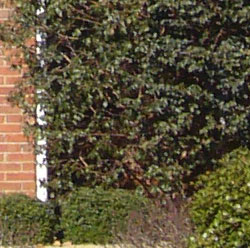 |
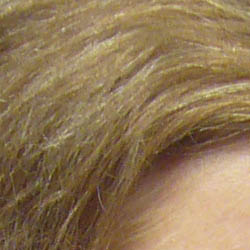 |
| Pretty good definition of high-contrast elements. | Subtle detail: Hair Noise suppression tends to blur detail in areas of subtle contrast, as in the darker parts of Marti's hair here. |
The Panasonic Lumix DMC-FX9's images are slightly soft overall, though details are still pretty well defined. There's no strong over-sharpening or edge enhancement on the camera's part, aside from some minor enhancement in very high contrast areas. (Edge enhancement creates the illusion of sharpness by enhancing colors and tones right at the edge of a rapid transition in color or tone.)
Noise-suppression systems in digital cameras tend to flatten-out detail in areas of subtle contrast. The effects can often be seen in shots of human hair, where the individual strands are lost and an almost "watercolor" look appears. The crop at far right shows this, with darker areas of Marti's hair showing only limited detail, even though individual strands are quite visible against the shadows. (The level of detail loss shown here isn't all that obvious on prints 8x10 inches or smaller though.)
ISO & Noise Performance
Moderate noise at the normal sensitivity settings, very high noise
that blurs detail at the higher settings.
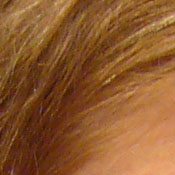 |
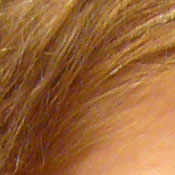 |
| ISO 80 | ISO 100 |
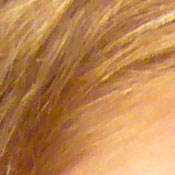 |
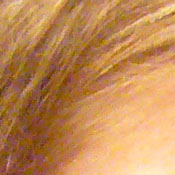 |
| ISO 200 | ISO 400 |
The DMC-FX9's lower ISO settings produced moderate noise, with only slightly blurred detail in the dark areas. As the ISO setting increases, so does the noise level and the amount of blurring that results, and its images at ISO 200 and 400 are quite soft, with bright noise pixels.
Extremes: Sunlit and low light tests
High resolution with good overall detail, though details are slightly
soft and contrast quite high. Limited low-light capabilities, barely sensitive
enough for average city street lighting.
| +0.3 EV | +0.7 EV | +1.0 EV |
Sunlight:
Because digital cameras are more like slide film than negative film (in that they tend to have a more limited tonal range), we test them in the harshest situations to see how they handle scenes with bright highlights and dark shadows, as well as what kind of sensitivity they have in low light. The shot above is designed to mimic the very harsh, contrasty effect of direct noonday sunlight, a very tough challenge for most digital cameras. (You can read details of this test here.)
The Panasonic Lumix DMC-FX9 had some trouble with the deliberately harsh lighting in the test above, producing a very high contrast exposure with washed-out highlights and deep shadows. Noise suppression is visible in the shadows, contributing to the loss of detail there. The exposure at +0.7 EV image is bright, but the midtones in the +0.3 EV shot are just too dark. (In "real life" though, be sure to use fill flash in situations like the one shown above; it's better to shoot in the shade when possible.)
Low light:
Our low light testing revealed some limitations in the lens and sensor's ability to gather and process light, as the Lumix FX9 captured bright, usable images only to the 1/2 foot-candle light level at ISO 400. You could arguably use the images captured at the lower ISO settings at the one foot-candle light level, though overall exposures are slightly dim. Color balance was good with the Auto white balance setting however. The camera's autofocus system worked well though, able to focus on the subject down to the 1/4 foot-candle light level without AF assist, and down to the 1/16 foot-candle level with AF assist enabled.
Color
Saturation & Hue Accuracy
Oversaturated color (especially strong reds and blues), with a slight
warm cast overall.
The other important part of color rendition is hue accuracy. Hue is "what color" the color is. The Lumix FX9 tended toward a warmer color cast in many instances, though results here should still be acceptable to most consumers.
Viewfinder
Coverage
Very good accuracy from the LCD monitor.
| 35mm eq., LCD monitor | 105mm eq., LCD monitor |
The Lumix FX9's LCD monitor showed close to about 100% frame accuracy at both zoom settings.
Flash
Coverage and Range
The DMC-FX9's small flash has a limited range, but performs fairly
well with household lighting.
| 35mm equivalent | 105mm equivalent |
| Normal Flash +1.0 EV | Slow-Sync Flash +1.0 EV |
Flash coverage was rather uneven at wide angle, and much dimmer at telephoto. On the Indoor Portrait, the Lumix FX9's flash underexposed our subject at its default setting, requiring a +1.0 EV exposure compensation adjustment to get bright results, which is about average. The camera's Slow-Sync mode produced more even lighting, though with a stronger orange cast from the room lighting. It too required a +1.0 EV exposure boost.
Even at eight feet, our closest test range, the flash did not quite illuminate the DaveBox target adequately.
| 8 ft | 9 ft | 10 ft | 11 ft | 12 ft | 13 ft | 14 ft |
| 1/60 sec f5.0 ISO 100 |
1/60 sec f5.0 ISO 100 |
1/60 sec f5.0 ISO 100 |
1/60 sec f5.0 ISO 100 |
1/60 sec f5.0 ISO 100 |
1/60 sec f5.0 ISO 100 |
1/60 sec f5.0 ISO 100 |
Output Quality
Print Quality
Good print quality, great color, very usable 11x14 inch prints. ISO 400 images are soft at 8x10, acceptable at 5x7, great at 4x6.
Testing hundreds of digital cameras, we've found that you can only tell just so much about a camera's image quality by viewing its images on-screen. Ultimately, there's no substitute for printing a lot of images and examining them closely. For this reason, we now routinely print sample images from the cameras we test on our Canon i9900 studio printer, and on the Canon iP5000 here in the office. (See the Canon i9900 review for details on that model.)
With the Panasonic Lumix FX9, we found that it had enough resolution to make very crisp 8x10 inch prints. At 11x14, its prints were a bit softer looking, but more than adequate for wall or table display. At high ISO, image noise levels are held in check, but at the cost of rather soft-looking images. ISO 200 photos look OK printed at 8x10 inches, but ISO 400 at this size is marginal. At 5x7 and 4x6 inches, ISO 400 images are great. Color-wise, the Lumix FX9's images looked excellent when printed on the iP5200, with bright, vibrant color.
Timing and Performance
Panasonic Lumix DMC-FX9 Timing
Good speed for a consumer camera.
| Startup/Shutdown: | |
| Power On to first shot | 1.8 seconds |
| Shutter response (Lag Time): | |
|
Full Autofocus Wide
|
0.52 second
|
|
Full Autofocus Tele
|
0.56 second
|
|
Prefocused
|
0.016 second
|
| Cycle time (shot to shot) | |
| Normal large/fine JPEG | 1.89 seconds |
| Flash recycling | 4 seconds |
| Continuous mode | 0.35 second 2.85 frames/second (6 large/fine frames) |
| Download speed | |
| Windows Computer, USB 2.0 | 875 KBytes/sec |
The Panasonic Lumix FX9's performance is pretty good, with a fast start up time, and good shutter response at wide angle and telephoto lens positions. "Prefocusing" the camera by half-pressing and holding down the shutter button before the final exposure, results in a blazingly fast response time of only 0.016 second. Shot to shot cycle times are about average, at about 1.89 seconds for large/fine JPEGs, and it can capture shots continuously at this speed. Continuous-mode speed is also good, at almost three frames/second, for up to six shots in succession. The flash takes about four seconds to recharge after a full-power shot, also pretty good. The Lumix FX9's download speeds are also pretty good. Bottom line, the Panasonic Lumix FX9's is responsive enough for most consumer needs, including sporting events and family photos.
Battery and Storage Capacity
Battery
Outstanding battery life according to CIPA standard.
| |
|
| CIPA standard runtime See description below |
240 Pictures |
The Panasonic Lumix FX9 uses a custom rechargeable 3.7V, 1150 mAh LiIon battery for power. The table above shows maximum run times based on the CIPA standard.
(Panasonic's statement on CIPA standard outline: Shooting conditions: 73.4°F with 50% humidity;LCD On; Using the included SD Memory Card; Starting to shoot 30 seconds after turning on the power; Shooting once every 30 seconds with the flash in full operation for every other shot; Changing the zoom setting from telephoto to wide, or wide to telephoto, for each shot; Temporarily turning the power off after each 10 shots (long enough to lower the battery temperature. For DMC-LC1: Shooting once every 30 seconds, flash in operation for every shot, 77°F(25°C) ambient temperature.)
Storage
A 16MB Compact Flash card is included with the Lumix DMC-FX9.
| 16MB Compact Flash card |
Fine | |
| 2,816 x 2,112 | Images | 5 |
| File Size | 5.8MB | |
| 2,048 x 1,536 | Images | 9 |
| File Size | 1.7MB | |
| 1,600 x 1,200 | Images | 15 |
| File Size | 1.0MB | |
| |
Images | 23 |
| File Size | 683K | |
| |
Images | 73 |
| File Size | 216K | |
I strongly recommend buying at least a 128MB card, preferably a 256MB one, to give yourself extra space for extended outings.
| Pro: | Con: |
|---|---|
|
|
The Panasonic Lumix DMC-FX9 seems about average at first, with a 3x zoom in a small, stylish body, and a big 2.5 inch LCD. But when you learn it has Panasonic's MegaOIS Optical Image Stabilization technology added, despite its average 3x zoom, that's better than average. Image stabilization is becoming a hot feature, capturing sharper images in lower light at low shutter speeds without raising ISO. Unfortunately, the FX9 needs the optical image stabilization to make up for its shortcomings in terms of low light and flash performance. Indoor shots will come out quite yellow, unfortunately, unless you go through the trouble to set white balance manually, which is a bit of a burden. Still, the Panasonic FX9 also offers 6-megapixel resolution, very bright color without oversaturating skin tones, good macro focusing, and excellent battery life. The Panasonic Lumix FX9 is a good little camera, and clearly one of the best bargains on the market for an optically stabilized digital camera. It just missed being named a "Dave's Pick," but it deserves your serious consideration if you're looking for a unique camera at a great price. You really can't match its combination of 6 megapixels, 3x zoom and optical image stabilization for anywhere near its price.
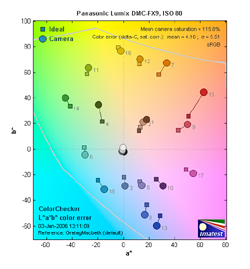

Follow Imaging Resource: